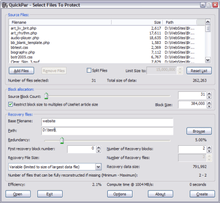QuickPar
|
QuickPar 0.9 checking a series of RAR files for integrity. | |
| Developer(s) | Peter Clements |
|---|---|
| Initial release | 0.1, (February 5, 2003)[1] |
| Stable release |
0.9.1
/ July 4, 2004[2] |
| Operating system | Microsoft Windows |
| Platform | x86 |
| Type | Data recovery |
| License | Proprietary, Freeware |
| Website |
www |
QuickPar is a computer program that creates parchives used as verification and recovery information for a file or group of files, and uses the recovery information, if available, to attempt to reconstruct the originals from the damaged files and the PAR volumes.
Designed for the Microsoft Windows operating system, it is often used to recover damaged or missing files that have been downloaded through Usenet.[3] QuickPar may also be used under Linux via Wine.[4]

There are two main versions of PAR files: PAR and PAR2. The PAR2 file format lifts many of its previous restrictions.[5] QuickPar is freeware but not open source. It uses the Reed-Solomon error correction algorithm internally to create the error correcting information.[6]
Abandonware
Though QuickPar works well, it is currently considered abandonware, since there have been no updates for it in 12 years. The software, MultiPar, is actively being developed by another author named Yutaka Sawada, who is adding support for the new PAR3 file format.
See also
References
- ↑ "QuickPar - Old Release Notes". Retrieved 2010-11-19.
- ↑ "QuickPar for Windows". Retrieved 2009-09-27.
- ↑ Wang, Wallace (2004-10-25). "Finding movies (or TV shows): Recovering missing RAR files with PAR and PAR2 files". Steal this File Sharing Book (1st ed.). San Francisco, California: No Starch Press. pp. 164 – 167. ISBN 1-59327-050-X. Retrieved 2009-09-24.
- ↑ Petersen, Richard (2009-05-01). "Internet Applications". Ubuntu 9.04 Desktop Handbook. Los Angeles, California: Surfing Turtle Press. p. 224. ISBN 0-9820998-4-3. Retrieved 2009-09-27.
- ↑ "QuickPar - About PAR2". Retrieved 2009-09-27.
- ↑ Fellows, G. (2006). "Newsgroups reborn – the binary posting renaissance". Digital Investigation. 3 (2): 73–78. doi:10.1016/j.diin.2006.04.006.
External links
- Official website
- QuickPar tutorial referencing Usenet downloads
- MultiPar, successor to QuickPar, supports PAR2, PAR3 and multicore cpu's
